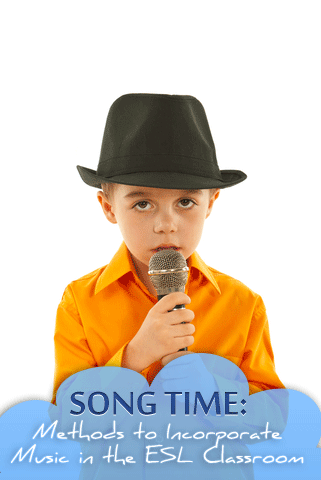If I Could Turn Back Time: 4 Ways to Use Pop Music to Teach Conditionals


In fact, many people excuse themselves from singing in public because of this alleged disability. In general, it seems we’d like to leave the singing to the professionals. So with this uneasiness surrounding it, why use singing in your ESL class?
All cultures have some kind of music, and so it is something students will relate to. Students may also be familiar in their own language with a song the teacher introduces and so will more easily learn the English version.
What better way to teach the critical language components of rhythm, stress, and intonation than through song, where these elements become emphasized and put to a beat? For example, the four-quarter time rhythm of most rock music mirrors the natural STRESS unstressed Stressed unstressed rhythm of English. When singing a song, the musical beat forces students into using the correct intonation pattern in a way they are not with a straight dialogue.
Singing together can have a magical effect of bonding you to those with whom you are singing. You become a community. It is probably for this reason that many religious groups have communal singing as part of their worship and that most nations have an anthem that citizens might sing together at public events.

Below is a list of songs I’ve included in my ESL classes with some success This is by no means exhaustive and is just an example of the kind of songs that might be incorporated in your class.
Despite its title, this song is sung mostly in English, except for the line “Que Sera, Sera,” which is immediately translated, “What Will Be, Will Be.” The song is the story of a child’s query to her mother “What will I Be?” and the mother’s response. I’ve had success with it as both the language and melody are simple and demonstrate multiple forms of the future tense, such as questions and affirmatives.
I’ve usually taught this song when showing the musical it comes from, “Fiddler on the Roof,” but it also works well on its own. The song features the main character, Tevye, a poor dairyman, and his musings on what he would do if he were rich. It’s particularly good in an ESL class because not only can most students identify with Tevye’s sentiments, the song models multiple forms of the unreal conditional: questions, affirmatives, and negatives.
I use part of this song, the ship captain’s morning greetings to his crew, in which he brags about his various accomplishments, like “hardly ever” being sick at sea or swearing. Again, the song is simple, and I use it to teach the frequency adverbs “ever,” “hardly ever,” and “almost never,” which are all featured in the song’s chorus.
“Philadelphia,” Bruce Springsteen’s haunting song from the movie with the same title, about the lead character’s struggle with AIDS. I’ve included it because of its memorable, descriptive language and to supplement a class discussion on AIDS.

Again, you don’t have to be an accomplished musician to use singing in your classroom. I have found, however, there are some guidelines to follow.
Singing is a tool in the class, not the class itself. It should be incorporated sparingly and when it fits in well with the class. For the HMS Pinafore song above, for example, I didn’t have access to the whole song’s lyrics and indeed did not even know them as I had not planned on using the song that day. However, the opportunity arose to use a line or two from the song that modeled adverbs of frequency: “I am never sick at sea.” “Never, ever, sir?” “Well, hardly ever!”
Model the lyrics. Either sing the lyrics yourself for the students, as I do with “Que Sera, Sera,” because of its simplicity, or play a CD, as I do with “Philadelphia,” because in the song Springsteen can do musical gymnastics with his voice that I can’t imitate. The students then, from you or the CD, can get an idea of how the song should sound.
Pass out, or write on the board, the lyrics to the song. Have students analyze and discuss the lyrics in terms of their grammar and vocabulary.
Now after hearing the song and analyzing the lyrics, students are ready to sing themselves. I actually, however, offer this as an optional step in most cases: again, when the song is simple. I would not ask ESL students to sing the “Philadelphia” song, especially when I can’t myself sing it. However, if students are eager to sing, I proceed—oftentimes, in fact, students come from a more musical background than mine and are used to n performing in church choirs or just singing at home with their families. If they are willing to proceed, then the instructor can include a variety of methods---besides just having students sing as one group, the room can also be split in two, for example, with one side playing the captain and the other the crew in the HMS Pinafore greeting.
However, if they can get past the discomfort, teachers will probably find singing has a positive effect on the class. They may even find they actually enjoy singing and aren’t such bad singers after all!
Do you use songs in your classroom? How often? Do you sing along? What are your (or your students’!) favorites? Please share your thoughts in the comments below!